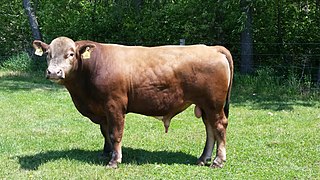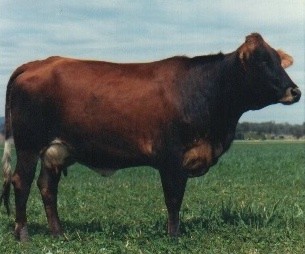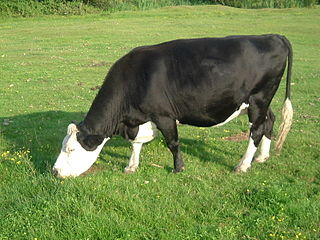
Beefalo constitutes a hybrid offspring of domestic cattle, usually a male in managed breeding programs, and the American bison, usually a female in managed breeding programs. The breed was created to combine the characteristics of both animals for beef production.

The zebu, sometimes known in the plural as indicine cattle, Camel cow or humped cattle, is a species or subspecies of domestic cattle originating in South Asia. Zebu, like many Sanga cattle breeds, differs from taurine cattle by a fatty hump on their shoulders, a large dewlap, and sometimes drooping ears. They are well adapted to withstanding high temperatures and are farmed throughout the tropics.

The Highland is a Scottish breed of rustic cattle. It originated in the Scottish Highlands and the Western Islands of Scotland and has long horns and a long shaggy coat. It is a hardy breed, able to withstand the intemperate conditions in the region. The first herd-book dates from 1885; two types – a smaller island type, usually black, and a larger mainland type, usually dun – were registered as a single breed. It is reared primarily for beef, and has been exported to several other countries.

The Charolais or Charolaise is a French breed of taurine beef cattle. It originates in, and is named for, the Charolais area surrounding Charolles, in the Saône-et-Loire department, in the Bourgogne-Franche-Comté region of eastern France.
A crossbreed is an organism with purebred parents of two different breeds, varieties, or populations. A domestic animal of unknown ancestry, where the breed status of only one parent or grandparent is known, may also be called a crossbreed though the term "mixed breed" is technically more accurate. Outcrossing is a type of crossbreeding used within a purebred breed to increase the genetic diversity within the breed, particularly when there is a need to avoid inbreeding.

The Simmental or Swiss Fleckvieh is a Swiss breed of dual-purpose cattle. It is named after the Simmental – the valley of the Simme river – in the Bernese Oberland, in the canton of Bern in Switzerland. The breed is typically reddish in colour with white markings, and is raised for both milk and meat.

Wagyu is the collective name for the four principal Japanese breeds of beef cattle. All wagyū cattle originate from early twentieth-century cross-breeding between native Japanese cattle and imported stock, mostly from Europe.

The Murray Grey is an Australian breed of polled beef cattle. It originated between 1905 and 1917 in the upper Murray River valley, on the border between New South Wales and Victoria. It is similar in appearance to the Aberdeen Angus, from which it largely derives, but is grey, silver or dun in colour.

A bovid hybrid is the hybrid offspring of members of two different species of the bovid family. There are 143 extant species of bovid, and the widespread domestication of several species has led to an interest in hybridisation for the purpose of encouraging traits useful to humans, and to preserve declining populations. Bovid hybrids may occur naturally through undirected interbreeding, traditional pastoral practices, or may be the result of modern interventions, sometimes bringing together species from different parts of the world.

The Senepol breed of beef cattle was developed on the Caribbean Island of St. Croix. It has long been thought that Senepol originated from just crosses between N'Dama cattle, imported in the late 19th century, and Red Poll cattle, but it is actually an admixed breed that consists of Red Poll, N'Dama, Criola and a trace amount of Zebu. The Senepol breed combines characteristics of heat tolerance and insect resistance with the docile nature, good meat, and high milk production of the Red Poll. They are polled, short haired, and colored red, black or brown.

Nelore or Nellore cattle originated from Ongole Cattle cattle originally brought to Brazil from India. They are named after the district of Nellore in Andhra Pradesh state in India. The Nelore has a distinct large hump over the top of the shoulder and neck. They have long legs which help them to walk in water and when grazing. The Nelore can adapt to all except very cold climates. They are very resistant to high temperatures and have natural resistance to various parasites and diseases. Brazil is the largest breeder of Nelore. Nelore have the shortest ears of most Bos indicus types. There is a naturally polled strain of the breed.

The Limousin, French: Limousine, is a French breed of beef cattle from the Limousin and Marche regions of France. It was formerly used mainly as a draught animal, but in modern times is reared for beef. A herd-book was established in France in 1886. With the mechanisation of agriculture in the twentieth century, numbers declined. In the 1960s there were still more than 250 000 head, but the future of the breed was not clear; it was proposed that it be merged with the other blonde draught breeds of south-western France – the Blonde des Pyrénées, the Blonde de Quercy and the Garonnaise – to form the new Blonde d'Aquitaine. Instead, a breeders' association was formed; new importance was given to extensive management, to performance recording and to exports. In the twenty-first century the Limousin is the second-most numerous beef breed in France after the Charolais. It is a world breed, raised in about eighty countries round the world, many of which have breed associations.

The Red Sindhi is a dairy breed of zebuine cattle. It is believed to originate in western Sindh and in the Las Bela area of Balochistan, now in Pakistan. It is widely kept in Pakistan, where in 2006 there were approximately 3000000 head; there are small numbers in India and in Bangladesh. Other names include Las Bela, Malir and Sindhi.

Beef cattle are cattle raised for meat production. The meat of mature or almost mature cattle is mostly known as beef. In beef production there are three main stages: cow-calf operations, backgrounding, and feedlot operations. The production cycle of the animals starts at cow-calf operations; this operation is designed specifically to breed cows for their offspring. From here the calves are backgrounded for a feedlot. Animals grown specifically for the feedlot are known as feeder cattle, the goal of these animals is fattening. Animals not grown for a feedlot are typically female and are commonly known as replacement heifers. While the principal use of beef cattle is meat production, other uses include leather, and beef by-products used in candy, shampoo, cosmetics, and insulin.

The Australian Friesian Sahiwal, is an Australian breed of dairy cattle whose development commenced in the 1960s by the Queensland Government. It is a combination of the Sahiwal, a dairy breed of Bos indicus from Pakistan and Holstein breeds, designed for the tropical regions of Australia. Cows produce approximately 3,000 litres of milk per lactation under tropical pasture conditions with a high resistance to heat, humidity, ticks and other parasites.

The Australian Charbray is an Australian breed of cattle derived from a cross between the French Charolais cattle and American Brahman cattle. The charbray breed was first conceived in the United States of America in the 1930s and later introduced into Australia in 1969. In Australia, Australian charbray breeders are concentrated in the tropical Northern regions of Queensland. As of 1977, the official breeder society of Charbray cattle in Australia and New Zealand is the Charbray Society of Australia Limited, responsible for recording Charbray cattle in herd books, fostering improvement, enhancement and sales of Charbray cattle.

The Black Hereford is a crossbreed of beef cattle produced in Britain and Ireland with Hereford beef bulls with Holstein-Friesian dairy cows. Black Herefords are not usually maintained from generation to generation, but are constantly produced as a byproduct of dairy farming as a terminal cross. They are one of the most common types of beef cattle in Britain and Ireland, outnumbering many pure beef breeds.

Cattle are large, domesticated, bovid ungulates widely kept as livestock. They are prominent modern members of the subfamily Bovinae and the most widespread species of the genus Bos. Mature female cattle are called cows and mature male cattle are bulls. Young female cattle are called heifers, young male cattle are oxen or bullocks, and castrated male cattle are known as steers.

Ongole cattle as called as Ongolu Gitta are an indigenous cattle breed that originates from Prakasam District in the state of Andhra Pradesh in India. The breed derives its name from the place the breed originates from, Ongole. The Ongole breed of cattle, Bos indicus, is in great demand as it is said to possess resistance to both foot and mouth disease and mad cow disease. These cattle are commonly used in bull fights in Mexico and some parts of East Africa due to their strength and aggressiveness. They also participate in traditional bull fights in Andhra Pradesh and Tamil Nadu. Cattle breeders use the fighting ability of the bulls to choose the right stock for breeding in terms of purity and strength. The mascot of the 2002 National Games of India was Veera, an Ongole Bull.

The history of French cattle breeding is the result of the intermingling of bovine populations from several European offshoots, after centuries of breeding and selection practices. The French herd includes crosses with zebus in the French overseas departments and territories.



















